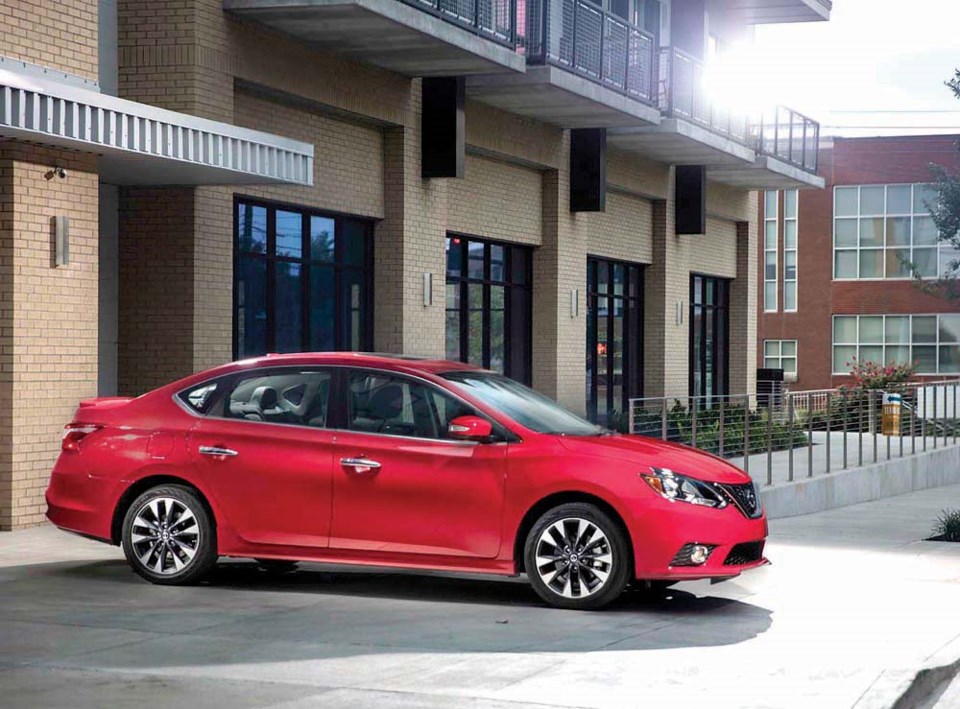Just released this week is the new Nissan Sentra SR Turbo, which takes the regular SR trim of Nissan’s compact sedan and adds on a supercharger. No, wait: a turbocharger.
As this new model has Turbo right in the name, you’d expect some worthy amount of thrust when you stomp on the accelerator – maybe even with some anime-style speed lines and lens-flares.
“Turboooo!” you shout as your shiny red Sentra rockets towards the freedom of the weekend.
Slow down there Super-Saiyan. The SR Turbo gets essentially the same engine as that found in the current Juke, a 1.6-litre direct-injection four-cylinder with a turbo bolted on. It makes 188 horsepower and 177 foot-pounds of torque, and while those are pretty sprightly figures for a small car, they’re hardly likely to pin you back in your seat like a moon rocket launch.
The SR Turbo sounds like a tuner special, but it is in fact just one more turbocharged car in a sea of machinery that’s adopting small-displacement forced-induction engines everywhere you look. The Ford Escape has two turbocharged engine options, and you can get a turbo’d V-6 in your F150 instead of a V-8. The ubiquitous Honda Civic comes with a 1.5-litre four-cylinder engine. The full-size Mazda CX-9 crossover doesn’t offer anything but a turbocharged four-cylinder engine. Luxury makers like Mercedes and BMW hardly offer any model that doesn’t include at least a couple of turbos.
Everybody gets turbos these days, and I’m not so sure that’s a good thing.
First, a little lesson as to what a turbocharger is, if you’re sitting there saying, “But my accounting software is called TurboTax and it seems OK.” Turbocharger is actually a contraction of turbosupercharger, a term used to describe any device that is capable of force-feeding air into an engine by using a turbine mounted in the exhaust stream.
Hot gases flow out of the exhaust manifold, spinning a bladed fan. That fan is connected by a shaft to an impeller, the impeller rams more air into the engine. Add more fuel to match the increased amount of oxygen you’ve managed to compress in there, and stand well back: power!
Why would you want to do such a thing? An engine is essentially an air pump, so packing more air and fuel into a cylinder before you ignite things with a sparkplug means you’ll get more power from the combustion. Because a turbocharger spins up as the throttle is pressed down, that means you can get away with a smaller displacement engine when you’re just cruising along. Smaller displacement is more efficient. Stricter fuel economy standards that are on the way require more efficiency, hence goodbye naturally aspirated BMW inline-six, and hello turbocharged BMW four cylinder.
However, that’s how things work on paper, not in the real world. In the real world, you aren’t just asking your engine to make power for the onramp, you’re speeding up and slowing down with the ebb and flow of traffic. That means you’re likely dipping into the boost zone more than the current fuel economy testing methods measure, and that means you’re using more fuel.
Further, turbocharged cars are often tuned to run rich as the boost pressure rises. Cramming all that air in there can lead to pre-ignition, or knock, and spraying a little extra fuel both combats the effect and reduces cylinder temperatures as it evaporates. If you rev up a naturally aspirated engine, things are a little more tightly controlled.
While annoyances like turbo-lag (the hesitation while the turbine spools up to provide power) have been greatly reduced, the tendency of turbocharged cars to drink more fuel than the figures on the window sticker would indicate will be a problem for many consumers. The person who’s interested in an SR Turbo might not mind – they might be after the sportiest version of a roomy compact sedan, and won’t mind burning a little more fuel. If you’re in the market for a WRX or a Golf R, you probably won’t care either. Power trumps efficiency.
However, if you’re just looking for a regular-grade family car that’ll handle the daily commute and return both good economy and better efficiency, the new age of turbocharging comes with a few asterisks attached. Not only will real world fuel consumption differ from official measurements, and depend heavily on driving style, but there’s also the question of reliability.
While your turbocharged car isn’t going to explode spontaneously (hopefully), it’s a more complex powerplant than a simple four or six cylinder. That means potential turbine replacement down the road – hopefully after you’ve traded it in, but if you keep your cars for ten years or more, it’s something to be aware of.
Turbo means fast, sure. It’s what the marketing teams want you to think. However, as the technology becomes ever more prevalent, just remember that there’s no magic going on here, just manufacturers trying to jump through regulatory hoops. It might be a new dawn for the prevalence of turbocharging, but it’s the same ol’ game behind the curtain.
Brendan McAleer is a freelance writer and automotive enthusiast. If you have a suggestion for a column, or would be interested in having your car club featured, please contact him at [email protected]. Follow Brendan on Twitter: @brendan_mcaleer.



